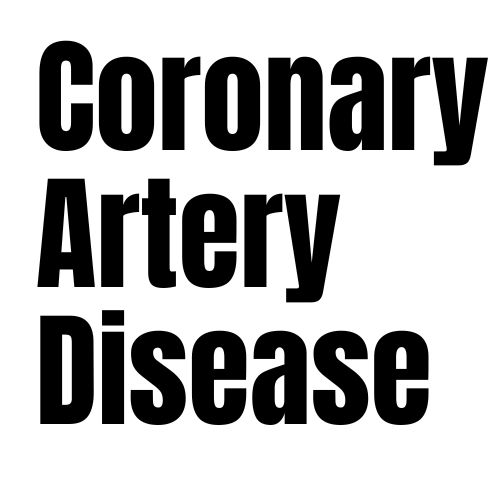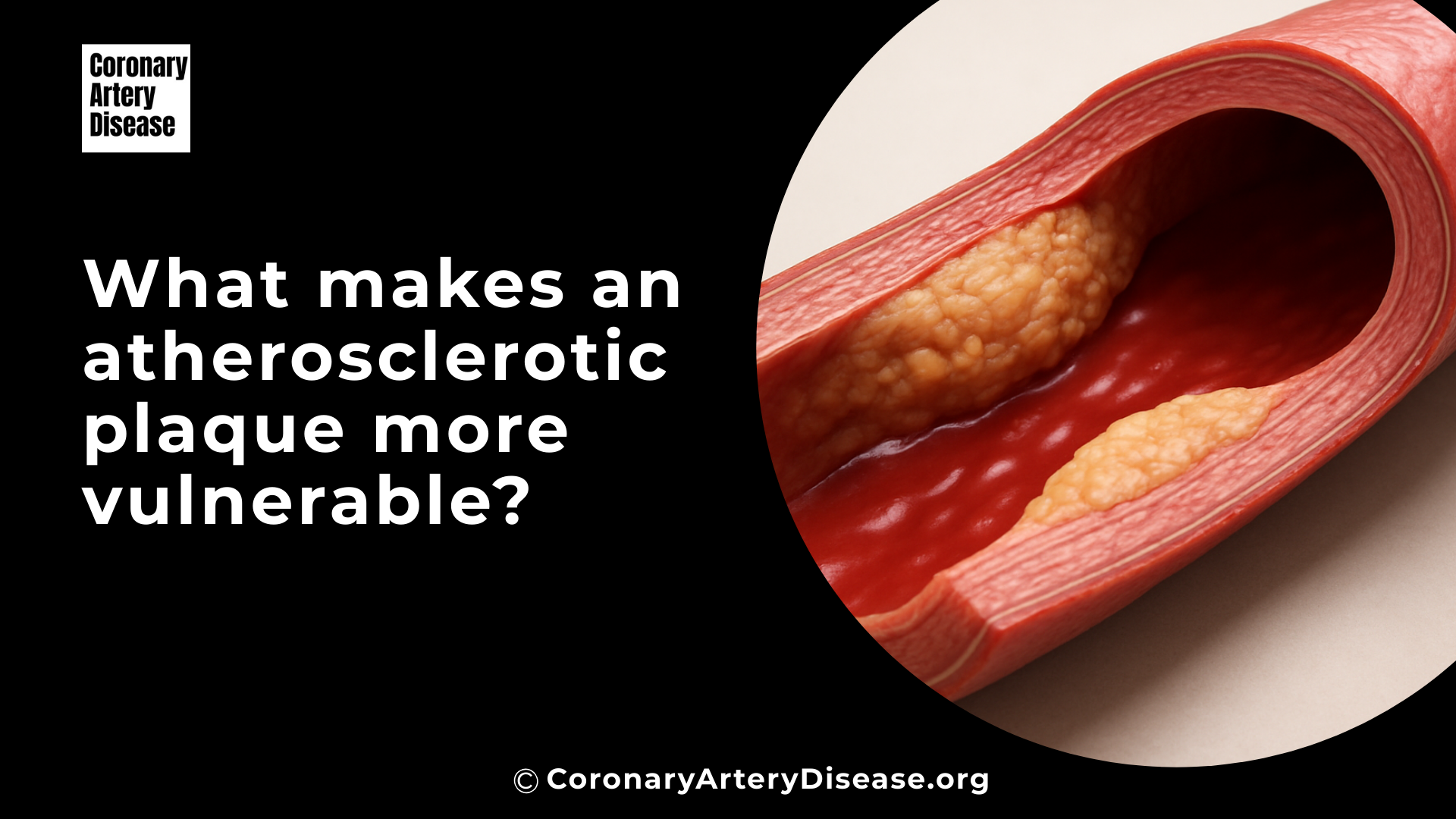Overview
Atherosclerotic plaques are deposits of fatty substances, cholesterol, and other materials that build up inside your arteries. Some atherosclerotic plaques are dangerous because they are more likely to rupture, or break open. When a plaque ruptures, it can lead to the formation of a blood clot (thrombosis) that blocks blood flow, causing serious events like a heart attack (myocardial infarction, MI) or a stroke.
These plaques are often referred to as vulnerable or high risk plaques because they significantly increase the chance of such life threatening cardiovascular events.
Understanding what makes a plaque vulnerable is crucial for prevention and treatment. Recent advancements in imaging technologies and ongoing research continue to shed light on the specific characteristics that contribute to a plaque becoming unstable and prone to rupture, helping medical professionals to better assess and manage risk in patients.
Quick List of Vulnerable Plaque Features
- Thin Fibrous Cap
- Large Lipid Core
- Inflammation and Macrophage Infiltration
- Spotty or Microcalcifications
- Intra-plaque Hemorrhage
- Low or Disturbed Blood Flow
- Overall Plaque Burden or Volume
- Positive Remodeling and Napkin Ring Sign
Thin Fibrous Cap:
Imagine the plaque as a balloon filled with soft material inside your artery. The fibrous cap is the outer wall of this balloon, acting as a protective layer that separates the plaque’s contents from your bloodstream. A thin fibrous cap is one of the most critical indicators of a vulnerable plaque because if this cap is too thin, it is mechanically weaker and more likely to break or tear. Pathological studies have suggested that plaques with a fibrous cap thickness of less than 65 micrometres (µm) are at high risk of rupture. When this thin cap ruptures, it exposes the highly thrombotic material within the plaque, leading to clot formation.
Large Lipid Core:
Inside the fibrous cap, particularly if it’s thin, lies the lipid core (also known as the necrotic core). This core is a collection of fatty material, cholesterol, and dead cells. The larger this lipid-rich core is, the more vulnerable the plaque becomes. This is because the lipid core contains a high amount of tissue factor, a substance that strongly triggers blood clotting. If a large lipid core is exposed to the bloodstream after the fibrous cap ruptures, it dramatically increases the chance of a significant and dangerous blood clot forming.
Inflammation and Macrophage Infiltration:
Inflammation plays a central role in the progression and instability of atherosclerotic plaques. Immune cells called macrophages are recruited to the plaque, where they take up lipids and transform into foam cells, contributing to the inflammatory process. These inflammatory cells, particularly macrophages, can produce enzymes (like matrix metalloproteinases) that degrade the fibrous cap, making it thinner and weaker. The presence of macrophages within the fibrous cap is therefore a key feature indicating increased plaque vulnerability and a higher risk of rupture.
Micro calcification:
The role of calcium in plaques can be complex. While large, dense areas of calcium are often associated with a more stable, hardened plaque, micro calcifications (very small calcium deposits) within the fibrous cap can actually increase plaque vulnerability. These tiny calcium specks can act as stress concentrators, meaning they create points of weakness in the cap, making it more prone to rupture under mechanical stress. These are early signs of atherosclerosis and can indicate active inflammation. Imaging techniques like coronary CT angiography (CCTA) can detect spotty calcifications, which are often predictive of acute coronary syndrome (ACS).
Intra Plaque Hemorrhage (IPH):
Intra plaque Hemorrhage refers to bleeding that occurs within the plaque itself. This internal bleeding can lead to a sudden increase in plaque volume and contributes significantly to the expansion of the lipid core. The accumulation of cholesterol rich red blood cell membranes from the Hemorrhage fuels the growth of the core and further destabilizes the plaque, making it more likely to rupture.
Flow Dynamics:
The way blood flows through your arteries exerts force on the vessel walls. Abnormalities in this force can contribute to plaque vulnerability. For instance, when blood flow is slow or turbulent, existing plaques become more prone to rupture or erosion. It can also promote inflammation and intra plaque bleeding. Disturbed blood flow, especially near artery branches, is associated with chronic endothelial activation and can lead to plaque erosion, a type of plaque instability where the surface lining of the artery peels away, exposing underlying tissue and triggering clot formation without a fibrous cap rupture.
Overall Plaque Burden or Volume:
While specific features make a plaque vulnerable, the total plaque volume (how much plaque has built up) or plaque burden (the amount of artery wall affected by plaque) is also a strong indicator of overall disease activity and risk. Studies show that plaques leading to acute coronary syndrome (ACS) often have significantly higher total plaque volumes. A larger plaque burden overall is associated with an increased risk of future adverse cardiovascular events.
Positive Remodeling and Napkin Ring Sign:
Positive remodeling occurs when the artery expands outwards to accommodate the growing plaque, preventing immediate narrowing of the vessel. While this initially preserves blood flow, it can mask the severity of the plaque within, making it harder to detect visually. The napkin ring sign, observed on CCTA imaging, is a specific pattern indicating a large lipid core surrounded by a high enhancing rim. This sign is strongly associated with thin cap and an increased risk of future adverse cardiovascular events.
Other Similar Questions:
- Can diet and exercise help make plaques less vulnerable? Yes, lifestyle changes like an improved diet, regular exercise, and stopping smoking, alongside medications, are crucial in helping to stabilise plaques and reduce their vulnerability.
- How do doctors identify these vulnerable plaques in living patients? Doctors use advanced imaging techniques such as Optical Coherence Tomography, Coronary Computed Tomography Angiography, Intravascular Ultrasound, and Near Infrared Spectroscopy to look inside the arteries and assess plaque characteristics like cap thickness, lipid content, and inflammation.
Resources:
- Hafiane, A. (2019). Vulnerable Plaque, Characteristics, Detection, and Potential Therapies. Journal of Cardiovascular Development and Disease, 6(3), 26.
- Sakamoto, A., Cornelissen, A., Sato, Y., Mori, M., Kawakami, R., Kawai, K., Ghosh, S. K. B., Xu, W., Abebe, B. G., Dikongue, A., Kolodgie, F. D., Virmani, R., & Finn, A. V. (2022). Vulnerable Plaque in Patients with Acute Coronary Syndrome: Identification, Importance, and Management. US Cardiology Review, 16, e01.
- Dawson, L. P., & Layland, J. (2022). High-Risk Coronary Plaque Features: A Narrative Review. Cardiology and Therapy, 11(3), 319–335.
- Kurihara, O., Takano, M., Miyauchi, Y., Mizuno, K., & Shimizu, W. (2021). Vulnerable atherosclerotic plaque features: findings from coronary imaging. Journal of Geriatric Cardiology, 18(7), 577–584.

